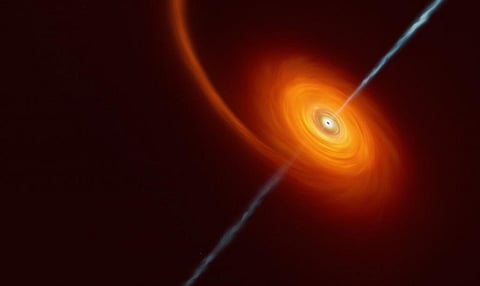

A mysterious and intensely bright flash of light coming from halfway across the universe earlier this year had stunned astronomers worldwide. The source of the intense beam has now been identified — a supermassive black hole ripping apart a star, pointing directly at Earth.
The jet of light was brighter than 1,000 trillion suns. Scientists from multiple institutions, including India, helped trace the activity powered by the black hole, 8.5 billion light years away from Earth. The findings are published in the journal Nature Astronomy.
The activity is called a tidal disruption event (TDE), which happens when a black hole shreds a nearby star as it feeds on it. As this happens, the supermassive black hole spews a jet of particles moving close to the speed of light.
This signal was detected in February 2022. Soon, astronomers turned multiple telescopes, scanning the light in various wavelengths: X-ray, ultraviolet, optical and radio bands.
This animation is an artist’s impression of how the material of a star fell towards the black hole at the centre of a distant galaxy, producing jets of matter and radiation. Because the jets are pointing almost towards us, the event, called AT 2022cmc, could be discovered from Earth with an optical telescope for the first time. Credit: ESO/M Kornmesser
They also used ISRO’s Astrosat for the analysis. This space telescope gathered data with its Soft X-ray Telescope and Ultraviolet Imaging Telescope, a statement from the Inter-University Centre for Astronomy and Astrophysics (IUCAA) read.
The signal named “AT 2022cmc” is the brightest TDE ever detected. It is also the farthest, according to scientists.
“It appears extremely bright because of an effect called Doppler boosting,” lead author Dheeraj Pasham, research scientist at MIT Kavli Institute for Astrophysics and Space Research, told Down To Earth.
“This is analogous to the doppler effect of sound, where an ambulance moving towards or away from you sounds louder or fainter,” the expert added.
The jet is likely pointing toward Earth, making the signal appear brighter than if it were pointing elsewhere, the scientists noted. AT 2022cmc is the fourth Doppler-boosted TDE detected. It is also the first such event record since 2011.
The source is 100 times brighter than the most powerful gamma-ray burst afterglow. “Brightness correlates with energy released or power,” Pasham highlighted.
Gamma-ray bursts — short-lived bursts of gamma-ray light — are known to be the brightest and strongest explosions in the universe. It is associated with the formation of black holes.
The afterglow follows the initial flashes of gamma-ray light, lasting a few seconds. They are often detected for weeks or even months. “This study showcases that such events can be used to uncover black holes at the edge of the Universe,” Pasham said.
Black holes sit quietly at the centres of galaxies until it is ignited by a TDE, unveiling a hidden population of black holes, he explained.
Further analysis helped researchers learn that the supermassive black hole was in a “hyper-feeding frenzy.” “It’s probably swallowing the star at the rate of half the mass of the sun per year,” Pasham said in a statement.
Researchers expect to catch more such TDEs in the future as more powerful telescopes are launched. “Then we might be able to say, finally, how exactly black holes launch these extremely powerful jets,” Matteo Lucchini, a postdoc at MIT’s Kavli Institute for Astrophysics and Space Research, said in a statement.
Further, such events can help reveal how black holes launch jets that are powerful enough to halt star formation in their host galaxies, Pasham said.